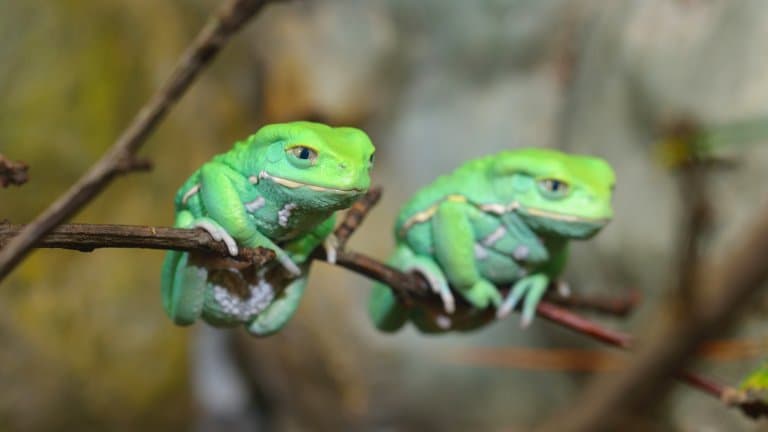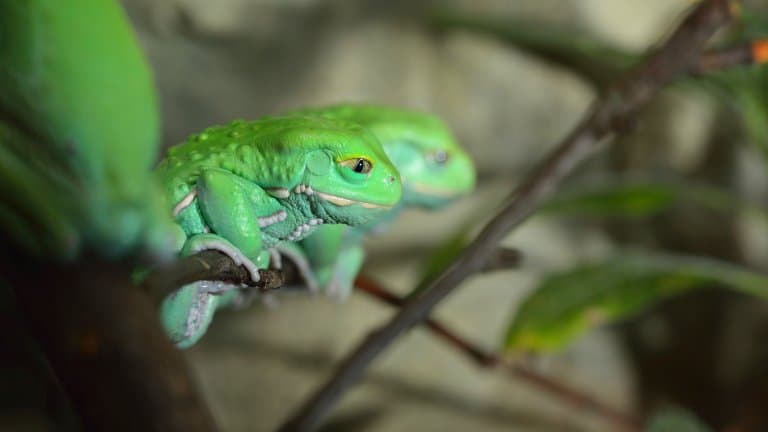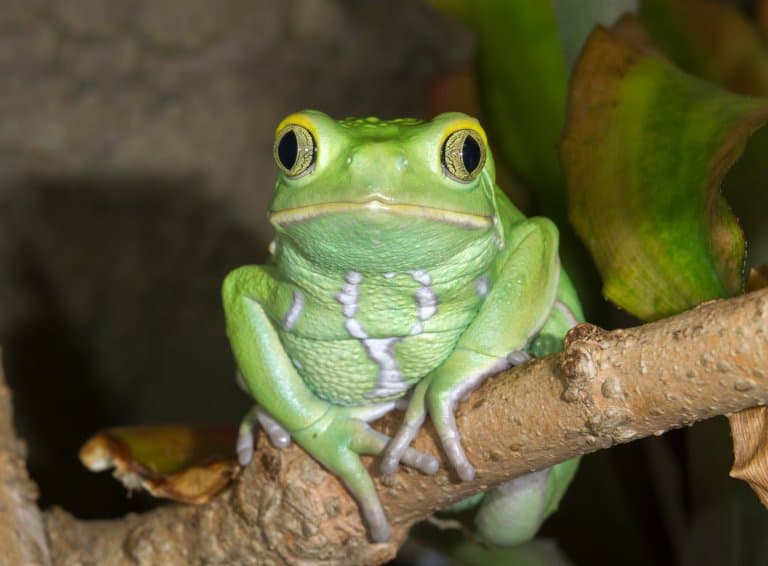Waxy Monkey Tree Frog Profile
The monkey frogs are a diverse genus of leaf or tree frogs from South America. Like all amphibians, they’re highly reliant on water to complete their life cycle, yet some have evolved to exist in exceptionally dry environments, at least for a frog.
The semi-arid regions of Paraguay are some of the places you might find a unique species of frog, equipped to make the most out of the scarce amounts of water available.
The waxy monkey tree frog also known as the waxy monkey leaf frog, is a curious example of evolution’s ability to create life where it should be impossible.

Waxy Monkey Tree Frog Facts Overview
| Habitat: | Hot, semi-arid lowlands |
| Location: | Bolivia, Paraguay, Brazil and Argentina |
| Lifespan: | More than 10 years in captivity |
| Size: | 10cm (4 inches) long |
| Weight: | Around 40g (1.4oz) |
| Colour: | Light brown to bright green |
| Diet: | Insects |
| Predators: | Scientists, collectors |
| Top Speed: | Slow |
| No. of Species: | 1 |
| Conservation Status: | Least Concern (IUCN) |
This curious nocturnal species of frog is native to South America, and is arboreal, which means it spends its time perching in trees and vegetation of the Gran Chaco.
They insectivorous and will eat insects, arachnids, and other invertebrates.
The waxy monkey tree frog is a specialist animal that has a number of unique adaptations to its environment, seemingly inspired by several other taxonomic lineages.
Their waste removal process is distinctly bird-like, their posture is quite simian, and their skin is more like the cuticle of a desert plant.
And this uniqueness is a problem for the species since it makes their habitats very hard to mimic, and so captive breeding has yet to keep up with the demand from scientists and collectors gathering these species from the wild.
Interesting Waxy Monkey Tree Frog Facts
1. They’re waxy
At least two-thirds of their name is accurate. These frogs are coated in a thick lipid layer that’s secreted from glands in the skin.
This waxy coating gives them a distinctive look and a unique moniker, but it serves a deeper purpose too.
This frog is a dry-weather specialist and has several adaptations that other amphibians don’t. A waxy coating is just one of the ways it holds onto water and protects itself against drying out in the absence of moisture. The frog’s natural sunblock even allows it to sit in direct sun without drying out.
This adaptation allows it to live far from water sources, and the chemical composition of the coating also helps maintain antimicrobial defences.
There is even potential for future developments in human antimicrobial treatments based on the discovery of these compounds, and researchers are eager to uncover their applications.
Some people, however, aren’t prepared to wait for science to figure it out. 1
2. They might give you hepatitis
If you’d never thought of cutting yourself open and putting frog secretions into the wounds, you’re hopefully unlikely to start now. But the same can’t be said for many misguided Europeans with willful ignorance of the mechanisms of body detoxification.
Inspired by an equally silly, yet culturally significant tribal practice called Kambô, case reports are emerging in which Europeans discontent with the rigour and decades of empirical support for Western medicine are resorting to dangerous niche and superstitious practices involving the waxy secretions of a Phyllomedusa species.
The compounds on the waxy monkey frog’s skin juices are still not well understood, but it’s safe to say they’re not something you want to introduce directly to your system, and at least with its sister species, Phyllomedusa bicolor, this practice has ironically caused toxic hepatitis, multiple organ damage and various other nasty outcomes.
Both of these species of frog may have significant applications to our understanding and administration of medicines, but, much like with herbal remedies, tapping the source directly comes with inherent risks due to various compounds and irregularities that can be dangerous, so it’s not a good idea! 2
3. They sit like a monkey
One of the notable characteristics of the waxy monkey frog is its unusual sitting posture. Instead of sitting with its legs tucked underneath its body, it sits upright with its arms and legs extended, almost as if it’s propping itself up.
This distinctive sitting position is likely another adaptation to its environment. More than just a casual flex, this might be a way of reducing surface contact and preventing the wicking of moisture from the skin.
It could also be a method of thermoregulation, or related to the way it spreads its waxy coating from the glands on its face all over its body each morning.
The exact reason remains a bit of a mystery, but it’s fun to think about the frog sitting uncomfortably after a fresh coating, like a beachgoer trying to avoid rubbing their sun lotion off on the lounger.

4. They pee like a bird
Our urine contains the final form of the waste products of metabolism. Urea is a salt, converted to a non-toxic, soluble from the far more toxic uric acid. The trade-off here is that we need to part with a lot of water to remove it, and so must drink every day.
Birds typically need to be light enough to fly, meaning they can’t afford to drink all that much water, and so can’t really spare any to dilute their waste products. As a result, they don’t convert ureic acid and instead excrete it as a sold. This solid is the recognisable white powder that corrodes the paint on your car and dries on your windows.
Most amphibians live where water is abundant, and so have a similar urinary system to us, but the waxy monkey tree frog has evolved as a dry environment specialist and has the waste removal strategy to match.
Like birds and many reptiles, adult frogs in this genus remove their nitrogenous waste as solids, allowing them to hold onto their valuable water. This is known as uricotelism. 3
5. They can hibernate
This is a bit of an exaggeration, but torpor is the word used for a resting state of low metabolism, most commonly recognised in over-wintering mammals like squirrels and bears who enter a state of torpor during hibernation.
The same process can be used when it’s too hot to function, and this is seen on a small scale in these frogs. During the day, when they’re not as active, the frogs enter torpor for short periods, likely as another way of regulating body temperature in hot environments.
This process is supplemented by an ability to mediate the quality of their waxy layer and control the amount of evaporation through their skin to further regulate their temperatures. 4

6. They’re victims of their own success
These adaptations combine to make them a prime target of both collectors and researchers and while the global population is still considered of Least Concern by the IUCN, their numbers in various localities are dropping as a result.
Captive breeding is notoriously difficult for animals so precisely adapted to specific conditions and has shown little to no success in this species. In P. bicolor, an artificial seasonal shift needs to take place to promote breeding, so it’s likely the precise conditions for the waxy monkey frog need to be meticulously simulated in order to succeed and reduce the pressure on wild populations.
7. They breed on leaves above water
Breeding in the wild is a complicated matter. Like many frogs, the male waxy monkey frog will ride the female, helping her place her eggs and fertilising them as they go. Unlike other frogs, this process occurs on the surface of a leaf, rather than in the water.
But as amphibians, the larvae do need water to complete the first stage of their life cycle, and this means the nest leaf needs to overhang a pool. On hatching, the tadpoles wriggle themselves off the leaf and into the pool to begin their journey.
This system allows the eggs to be laid as early as possible before the rains come and also protects the eggs from predation by aquatic predators, and is seen in other species of this genus too.
Waxy Monkey Tree Frog Fact-File Summary
Scientific Classification
| Kingdom: | Animalia |
| Phylum: | Chordata |
| Class: | Amphibia |
| Order: | Anura |
| Family: | Hylidae |
| Family: | Phyllomedusa |
| Family: | Phyllomedusa Sauvagii |
Fact Sources & References
- Zahid Raja (2013), “Structure, Antimicrobial Activities and Mode of Interaction with Membranes of Bovel Phylloseptins from the Painted-Belly Leaf Frog, Phyllomedusa sauvagii”, PubMed Central.
- Joanna Pogorzelska (2017), “Toxic hepatitis caused by the excretions of the Phyllomedusa bicolor frog – a case report”, NIH.
- “They aren’t reptiles: The awesomely unique world of Amphibians”, Reptile Apartment.
- Lynn A. Blaylock (1976), “Skin Structure and Wiping Behavior of Phyllomedusine Frogs”, JSTOR.
